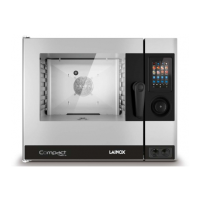
Do you have a question about the Lainox NABOO NAEB201 and is the answer not in the manual?
| Model | NABOO NAEB201 |
|---|---|
| Capacity | 20 x 1/1 GN |
| Power Supply | Electric |
| Voltage | 400 V |
| Frequency | 50/60 Hz |
| Temperature Range | 30 - 300 °C |
| Control Type | Touchscreen |
| Connectivity | Wi-Fi |
Ensures adequate room ventilation for ovens, especially with gas installations, adhering to regulations.
Details flue gas extraction requirements for type B13/B23 and necessary agency authorization.
Specifies IEC rules for a multiple pole switch with a minimum 3mm contact gap for safety.
Covers gas supply plumbing installation per regulations, including a type-tested shutoff valve.
Covers compliance with local building codes, IEC electrical standards, and fire prevention rules.
Mandates following regulations from gas supply companies, electrical providers, and other local authorities.
Instructs to complete water, electrical, and gas connections before permanently installing the oven.
Explains the Type Y attachment and the installer's role in providing connection hardware.
Mandates connecting the oven to an equipotential system via a 10 mm² conductor.
States that electrical safety depends on proper connection to an efficient earth system.
Advises immediate replacement of a damaged supply cord by qualified personnel.
Stresses correct neutral pin connection to the supply line for proper burner operation.
Recommends checking neutral potential to prevent operational faults, consulting electricians if needed.
Defines acceptable water pressure (200-500 kPa) and the need for a pressure reduction valve if higher.
Specifies draining parameters: DN 50 pipe, max 2m length, min 4° angle, and drain location.
Details the installation process for ovens equipped with the Calout system, including tank setup.
Prohibits shutting, blocking, or ducting vents A and B into other pipes to ensure proper function.
Covers gas connection types, pipe sizing, and the mandatory shutoff valve for safety.
Discusses flue gas exhaustion for different installation types (A3, B13, B23) and associated temperature risks.
Outlines key factors for commissioning: inlet pressure, calorific value, and primary air amount.
Stresses not commissioning the appliance if inlet pressure falls outside specified limits.
Explains how to test burner operation, including pre-ventilation, ignition, and speed cycle stages.
Lists essential checks post-connection: film removal, clear vents, secure connections, safety compliance, and leak tests.
Instructs to light the oven and verify smooth burner ignition according to the user manual.
Details completing the test report, submitting it, and its role in initiating the oven's warranty period.
Emphasizes that all repairs and maintenance must be performed only by authorized service agents.











